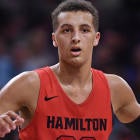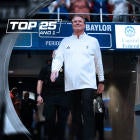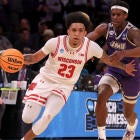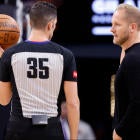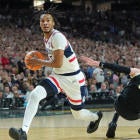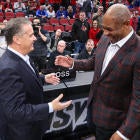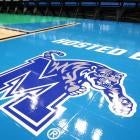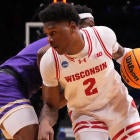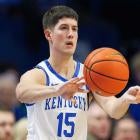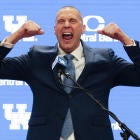
There's Buddy Boeheim at Syracuse. There's Doug McDermott at Creighton. There's even R.J. Hunter at Georgia State or Brendan and Matt McKillop at Davidson. If you want to find examples of coaches' sons who have found success playing for their fathers in college, you'll find the list is lengthy.
But in committing to Milwaukee and his father Patrick Baldwin Sr. on Wednesday, five-star recruit Patrick Baldwin Jr. joined an even more exclusive group. Unlike the aforementioned names, he's a top-40 national talent heading to a mid-major to play for his dad. That doesn't happen often. So in choosing to do so, he's venturing a path only a handful have traveled in the modern recruiting era (since 2003) and on which even fewer have produced a success story.
To be clear: Baldwin Jr. is undoubtedly in his own tier on these lists (which we will get to in a second). Once ranked the top overall player in his class prior to a season-ending ankle injury, he's a projected one-and-done with lottery potential who, when healthy, could be a contender for the No. 1 pick in 2022. But as you'll see below, launching from his position to the lottery as he's expected to do will blaze a new trail among players close to his caliber with NBA aspirations.
Gary Parrish and Matt Norlander examine No. 4 overall prospect Pat Baldwin Jr.'s commitment to Milwaukee on the latest edition of the Eye on College Basketball podcast. Listen and subscribe below.
Let's take a look back now at some players from the past who have dealt with similar situations to that of Baldwin Jr., from top prospects who chose smaller programs to be with the men who raised them to prominent recruits who shunned the bigger schools in favor of mid-majors.
Trey Zeigler | Central Michigan | Shooting Guard
247Sports ranking: No. 35 overall in 2010
Prior to Zeigler committing to play for his father, Ernie, at Central Michigan, the elder Zeigler was 54-69 overall. In four seasons, he had not recorded an above-.500 record. The high water mark prior to Trey's arrival came in 2009-10, when the Chippewas went 15-15 and sat alone atop the division standings.
Things quickly fell apart thereafter. Trey was plenty productive -- he averaged 16.0 points and 6.1 boards in two seasons -- but the team went 10-21 and 11-21 in those years. They were Ernie's last before he was shown the door. Trey went on to Pittsburgh then concluded his career at TCU. Despite the turbulence, he's managed to carve out a nice professional playing career, though his skills never materialized into the NBA. As for Ernie, he's not been a head coach since, but has found footing as a long-time assistant at Mississippi State.
Ray McCallum Jr. | Detroit | Point Guard
247Sports ranking: No. 26 overall in 2010
Whereas Central Michigan mostly fell apart with the Zeigler experiment, Detroit was able to find success when Ray McCallum Jr. committed to play for his father, Ray McCallum. He went a combined 27-37 in his first two seasons with the Titans without his son, and a combined 69-53 with him. Ultimately, it was something of a short-term fix. The three seasons after McCallum Jr. left, Detroit went 44-52 and he was fired after the 2015-16 season.
McCallum Jr. spent a few seasons in the NBA after being drafted 36th overall in 2013. He averaged a combined 6.0 points and 2.4 assists with the Kings, Spurs and Grizzlies.
Notable lower-rated recruits who played for their dad
- Doug McDermott (No. 155 overall in 2010 class) to Creighton: Averaged 21.7 points and 7.5 rebounds per game in four seasons, earning National Player of the Year honors in 2014. He was drafted No. 11 overall in 2014.
- Buddy Boeheim (No. 349 overall in 2018 class) to Syracuse: Averaged 12.9 points and 2.0 rebounds per game on 37.1% 3-point shooting in three seasons.
- R.J. Hunter (No. 283 overall in 2012 class) to Georgia State: Averaged 18.4 points and 4.8 rebounds per game in three seasons. Earned Sun Belt Player of the Year honors twice before being drafted No. 28 overall in 2015.
- Bryce Alford (No. 396 overall in 2013 class) to UCLA: Averaged 13.6 PPG, 2.6 APG, 2.5 RPG in four seasons with UCLA. Made 105 career starts and earned All-Pac 12 honors in 2016-17.
Top-10 recruits to choose mid-majors since 2003
- Anthony Bennett (No. 6 overall in 2012 class) to UNLV: Averaged 16.1 points per game and became the No. 1 draft pick in 2013.
- Emmanuel Mudiay (No. 2 overall in 2014 class) to SMU: Never played in college and went overseas before being drafted No. 7 overall in 2015.
- Mitchell Robinson (No. 9 overall in 2017 class) to Western Kentucky: Never played in college and trained stateside before being drafted No. 36 overall in 2018.
- Charles Bassey (No. 6 overall in 2018 class) to Western Kentucky: Reigning Conference USA Player of the Year and potential first-round pick.
How Baldwin Jr.'s career might go
On paper, the Baldwin-Baldwin Jr. pairing looks to be a match. Milwaukee has an experienced roster to complement Baldwin Jr. and a proven star in DeAndre Gholston, who last season led the team in scoring. Together, they should form one of the most lethal 1-2 combos in the Horizon League. That might be enough to give the Panthers their first winning season since 2015-16.
For Baldwin Jr., he'll immediately be a star. He has a chance to be the top freshman in college basketball as well as the best and most productive player in the league. If he dominates -- or even if he doesn't -- his pedigree, size and skill should have him on track to be a first-rounder in 2022. The big question from this is whether Baldwin Sr. can use this breath of fresh air as a coach to extend his coaching career and really build something, or if the struggles the last few seasons continue.












